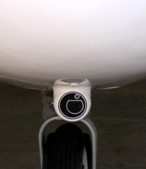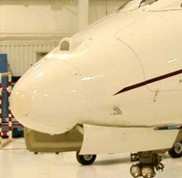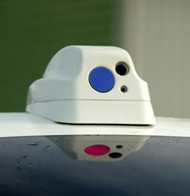Covers Spectrum From Bizjets To Smallest GA Aircraft
 Max-Viz, Inc. told ANN
Thursday of three new systems which encompass all segments of
commercial aviation, from general aviation piston to corporate jet,
helicopter and commercial airline transport aircraft.
Max-Viz, Inc. told ANN
Thursday of three new systems which encompass all segments of
commercial aviation, from general aviation piston to corporate jet,
helicopter and commercial airline transport aircraft.
"The good news for our current customers," said Jim Tuttle,
Max-Viz president and CEO, "is that two out of the three new
products are identical in form factor to our current EVS-1000 and
EVS-2000 products while offering greatly improved performance and
additional functionality asked for by pilots, airframe, and Avionic
OEMs. This makes upgrades simple and inexpensive for aircraft
currently outfitted with our EVS-1000 or EVS 2000 systems."
Max-Viz announced the EVS-1500 (right), an addition to the
existing EVS-1000 product line that is STC'd and flying on over 150
helicopters and corporate jets.
The EVS-1500 features pilot selectable dual field of view using
high performance optical zoom that switches from wide angle (53
degrees) to telephoto (30 degrees), as well as improved electronics
and image processing software.
The wide angle gives maximum peripheral visibility to fixed wing
aircraft during ground operations and is particularly helpful to
rotary aircraft operators who need to clear a landing site from a
safe distance.
 The zoom feature
provides a narrow field of view which is useful to fixed wing
operators in providing early runway acquisition and detection of
incursions during takeoff, approach and landing. For rotary
operators, the narrow field of view helps detect hard to see
obstacles sooner.
The zoom feature
provides a narrow field of view which is useful to fixed wing
operators in providing early runway acquisition and detection of
incursions during takeoff, approach and landing. For rotary
operators, the narrow field of view helps detect hard to see
obstacles sooner.
"Upgrades from EVS-1000 to EVS-1500 are quick and easy," said
Tuttle. "The camera and power supply LRU's are identical in form,
weight and power consumption. Over 45 current STC's for our
EVS-1000 are being modified to accept the EVS-1500."
Max-Viz' second new product for 2007 is the EVS-2200 (right). A
derivative of the EVS-2000, currently type certificated on the
Cessna Citation X, the EVS-2200 features triple sensor fusion for
heads down display, full HUD and SVS integration.
The system is the most sensitive, stable and functional EVS
sensor suite available to commercial aviation today.
The company says its EVS-2200 is the only system capable of
sensing diode lights, critical for detecting next generation
airport LED lighting systems while maintaining capability to see
current runway incandescent lights.
"The Max-Viz EVS-2200 is the pinnacle of EVS sensor technology,"
said Tuttle, "That is why its offshoot, the EFVS-2100 was selected
by Rockwell Collins for HUD integration on the Boeing Business Jet
for landing credits."
 The EVS-100 (right) is
the third -- and potentially the most exciting -- new system.
Designed specifically with general aviation helicopters as well as
fixed wing piston and light turboprop aircraft in mind, it is light
(weighs less than 1.5 pounds), enclosed in an aerodynamic fairing
and mounts on the aircraft just like an antenna.
The EVS-100 (right) is
the third -- and potentially the most exciting -- new system.
Designed specifically with general aviation helicopters as well as
fixed wing piston and light turboprop aircraft in mind, it is light
(weighs less than 1.5 pounds), enclosed in an aerodynamic fairing
and mounts on the aircraft just like an antenna.
The system turns night into day, enabling pilots to see four to
10 times further in marginal VFR conditions through most
atmospheric obscurations. Max-Viz says the new system will allow
VFR pilots to fly comfortably at night, enjoying clear views of the
ground, seeing emergency landing fields, roads, lakes, and
buildings.
And, because the system sees dense atmospheric buildups at
night, VFR pilots need not worry about accidentally flying into a
cloud. This EVS-100 greatly enhances the utility of the airplane,
improves the comfort level of passengers, and increases the safety
of each flight.
The EVS-100 is available for retrofit today from Forward Vision,
and is becoming available through selected OEM's now, according to
Max-Viz representatives.
 ANN's Daily Aero-Term (12.19.25): Ultrahigh Frequency (UHF)
ANN's Daily Aero-Term (12.19.25): Ultrahigh Frequency (UHF) NTSB Prelim: Cirrus Design Corp SR22T
NTSB Prelim: Cirrus Design Corp SR22T Classic Aero-TV: The Red Tail Project--Carrying the Torch of the Tuskegee Airmen
Classic Aero-TV: The Red Tail Project--Carrying the Torch of the Tuskegee Airmen Aero-News: Quote of the Day (12.19.25)
Aero-News: Quote of the Day (12.19.25) Airborne 12.17.25: Skydiver Hooks Tail, Cooper Rotax Mount, NTSB v NDAA
Airborne 12.17.25: Skydiver Hooks Tail, Cooper Rotax Mount, NTSB v NDAA





